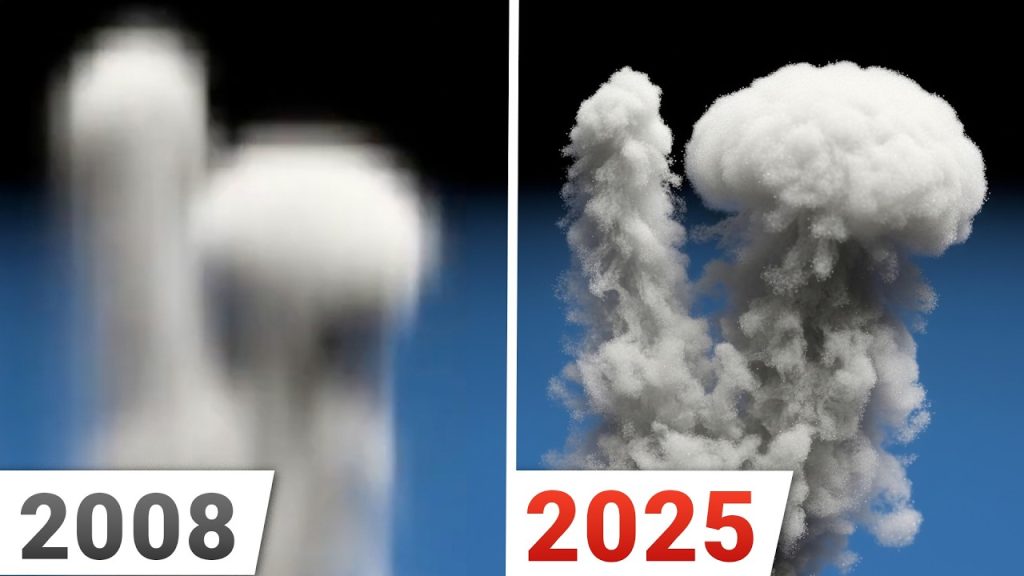Asteroid Crash: Billion-Particle Simulation Achieved Without AI. The Secret Revealed.

Revolutionary Fluid Simulation: A Leap Beyond Wavelet Turbulence
I was absolutely blown away when scientists involved in groundbreaking new research reached out to me. What they’ve achieved is nothing short of revolutionary, and I couldn’t wait to share it with you.
Prepare to have your perception of reality challenged because what you’re about to see is not real. It’s a computer simulation, but one that redefines the possibilities of fluid dynamics.
The Legacy of Wavelet Turbulence
This new work builds upon the foundation of what I consider to be one of the most brilliant papers ever written: Wavelet Turbulence. This technique cleverly addressed the inherent trade-off between simulation speed and visual fidelity.
Low-resolution simulations are quick to compute but lack detail, while high-resolution simulations, although stunning, can take an impractical amount of time. Wavelet Turbulence offered a solution: generate a coarse simulation rapidly and then enhance it to breathtaking quality. This paper was so impactful that it even earned a Technical Oscar.
Limitations of Grid-Based Systems
Despite its brilliance, Wavelet Turbulence had its limitations. It simulated fluids within a fixed box of cells. Nothing happens outside that boundary. To capture a large scene, the box had to be expanded, drastically increasing memory and computational costs, ultimately reducing efficiency.
For very large areas, grid-based systems become less appealing due to these computational constraints.
Particle-Based Solutions: Freedom Beyond the Grid
Particle-based techniques offered a promising alternative, as particles are not confined to a grid. They can move freely, eliminating the limitations of the box.
Okay, great right? Well, not exactly.
The Challenge of Neighbor Searches
While particles solve the grid issue, they introduce their own inefficiencies at large scales. To accurately compute properties like pressure, density, and surface tension, particles need to interact with their neighbors.
Each particle must search for all nearby particles within a certain radius to determine how dense the fluid is around it. This neighbor search must be repeated at every time step.
Imagine you need signatures for a petition. Asking a couple of neighbors wouldn’t be a problem. However, now imagine that you have billions and billions of neighbors!
This constant neighbor search becomes computationally expensive, hindering the simulation’s speed and scalability.
The Innovative Solution
So, how does this new research overcome these hurdles? They’ve developed a novel approach that cleverly combines the strengths of both grid-based and particle-based methods while mitigating their weaknesses.
I can’t share the details of the exact algorithm, but the results speak for themselves. The simulations are incredibly detailed, visually stunning, and, most importantly, computationally efficient. This breakthrough paves the way for simulating large-scale fluid dynamics with unprecedented accuracy and speed.
Applications and Future Implications
This advancements have profound implications for various fields, including:
- Visual Effects (VFX): Creating realistic and dynamic water, smoke, and fire effects for movies and video games.
- Engineering: Simulating airflow around vehicles, water flow in pipelines, and other fluid-related phenomena.
- Scientific Research: Studying complex fluid systems like ocean currents and atmospheric turbulence.
- Climate Modeling: Developing more accurate climate models that incorporate fluid dynamics.
This research represents a significant leap forward in fluid simulation technology, unlocking new possibilities for scientific discovery and technological advancement. I am genuinely excited to see how this technology evolves and what new wonders it will bring.
#Needed #Particle #Asteroid #Crash #Simulation
Source Link: https://www.youtube.com/watch?v=LhzKXjwC8vE






Most underrated science youtuber
I think they need to remake ‘The Dambusters’!😂
I wonder how well this would work with simulations on astronomical scales (planets colliding)
Always excited to see new papers in my feed!
Super efficient city hall clerk? Those words wheren't combined in any language ever before
peak paper!🔥 thanks for the great video, as always.
Please more papers not about AI, this is awesome!!! 🙏
I'm sad to say, but AI will kill cost-intensive, high-res simulation at VFX very soon.
Wow
Looks amazing! Thanks for showcasing cool ai physics and graphics projects bud 👍
Wow, really nice topics, especially this one I am really excited to see what is coming next after this.
As a vfx artist, i agree that wavelet turbulence is one of the most important papers ever written to advance the digital art field, up there with some of the original GI light transport papers. If theres another major advancement to this in my lifetime that actually hits real software, that would definitely be something.
The audio on this video is cracking/fuzzy. Too much compression?
does this compute as detailed on a small scale as well? like hyper detail in 1cm x 1cm x 1cm?
Two Minute Goosebumps
Only a couple minutes a frame on the CPU is insane! If/when this can get optimized for gpu compute, then my dream of real time high definition fluid simulation in video games will finally be able to happen
please stop using ai images in your videos
We are reaching the actual demonstration that we are living in a simulation
очень впечатляет
We need hardware that is x1,000,000 faster for the same cost
The piss filter AI images detract from the rest of the quality of the video!
It's unfortunate as your videos are really great otherwise
i dont need this i dont need this. I NEED THIS!!!!
Name of the software: Houdini.
Is the industry standard to do physical simulations in games and cinema. Learn to use it and be a hero. Thank me later.
👋 Fellow Scholars
I love how you explained this!
Thank you for your video! This is amazing! What a time to be alive! 🙂
so, is this paper useful "only" for kinematic rendering aims? no dynamic simulation?
what a time to be alive
I beg your pardon, ON A SINGLE CPU ??? all of that was run on a single consumer grade cpu? This is an indie movie maker's dream, not to mention some game devs, wonder how this would run on hardware from a few years down the line.
At first I was like there is no way there is going to be 2 minutes of this…
"Absolutely brilliant work! 👏 Your hard work and dedication really shows in every detail. Keep inspiring us!"
the intro at 4:22
you're a clown
Amazing!
Thank you showing us the papers, I would never had time to read them 👍🤝
How are people so smart, This is so crazy
Goodbye for Houdini ocean artists.
I don't understand how this can be used? We need to create a waterfall. Or will this product be released in 8-13 years? More promises?
Nah bro, ts is way better without AI sloppy pictures
Unlike real governments 😂